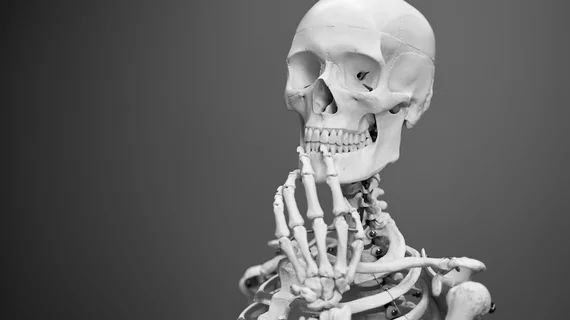Ultrasound assesses bone health similarly to DXA, study finds
Ultrasound scans of the calcaneus—or the heel bone—were equal to results gathered from dual-energy x-ray absorptiometry (DXA) for assessing bone health, according to new research published online in the March issue of The Journal of the American Osteopathic Association.
The study suggests that ultrasound could be offered as a low-cost, more accessible method of screening for osteoporosis and other bone diseases, wrote researchers led by Carolyn Komar, PhD, associate professor of biomedical sciences at the West Virginia School of Osteopathic Medicine in Lewisburg.
“Ultrasonography of the calcaneus offers a low-cost, efficient means to screen bone health. The affordability and mobility of a US [ultrasound] machine enables its use as a screening method that may be applicable to large numbers of people,” Komar et al. wrote.
Bone mineral density (BMD) is measured to assess bone health, with various factors including nutrition, lifestyle, environment, physical activity and genetics contributing to an individual's overall BMD. Peak BMD is established by mid- to late-20s and only decreases naturally with age.
DXA scans have been and remain the gold standard for measuring BMD, however the equipment is expensive, immobile and the test exposes patients to ionizing radiation, according to the researchers.
For the study, Komar and colleagues recruited 99 patients scheduled for DXA scans at a rural primary care facility in Lewisburg, West Virginia from June 2015 to June 2016. All patients underwent ultrasounds for their left and right heel bone, as well as blood tests to determine vitamin D levels. Additionally, data was collected regarding Fracture Risk Assessment tool parameters, menstrual history and drug and supplement use.
A BMD score of the spine, or a T score greater than –1.05 indicated good bone quality and a score of less than –1.05 indicated poor bone quality when using ultrasound for BMD screening, the researchers noted. Ultrasound T scores for the right and left foot of each patient was recorded and then compared with results from the DXA exams.
The team noted that an ultrasound T score was chosen to evaluate bone health because the diagnosis of osteoporosis is determined by a DXA BMD T score, which most physicians recognize.
The researchers found the ultrasound scans of either the left or right foot were predictive of good or poor bone quality. There were no differences observed in the patients’ scans of the left and right foot.
The cutoff point was −1.30 for the ultrasound BMD T score of the left foot to predict good versus poor bone quality as determined by DXA scan area under the curve analysis; the cutoff point value was −1.05 for the right foot, the researchers concluded.
“Using ultrasound to scan the heel won’t give us all the information we could gather with a full DXA scan,” Komar said in a prepared statement. “However, it gives us a clear enough snapshot to know whether we should be concerned for the patient.”

